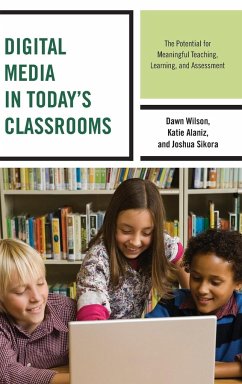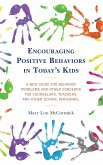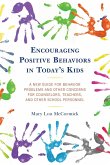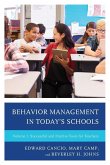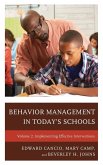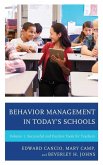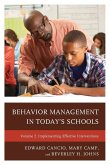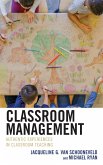Dawn Wilson, Katie Alaniz, Joshua Sikora
Digital Media in Today's Classrooms
The Potential for Meaningful Teaching, Learning, and Assessment
Dawn Wilson, Katie Alaniz, Joshua Sikora
Digital Media in Today's Classrooms
The Potential for Meaningful Teaching, Learning, and Assessment
- Gebundenes Buch
- Merkliste
- Auf die Merkliste
- Bewerten Bewerten
- Teilen
- Produkt teilen
- Produkterinnerung
- Produkterinnerung
The purpose of this book is to help guide teachers and students in benefiting from the vast potential of educationally-driven digital media as a tool for meaningful teaching, learning, and assessment.
Andere Kunden interessierten sich auch für
![Encouraging Positive Behaviors in Today's Kids Encouraging Positive Behaviors in Today's Kids]() Mary Lou McCormickEncouraging Positive Behaviors in Today's Kids70,99 €
Mary Lou McCormickEncouraging Positive Behaviors in Today's Kids70,99 €![Encouraging Positive Behaviors in Today's Kids Encouraging Positive Behaviors in Today's Kids]() Mary Lou McCormickEncouraging Positive Behaviors in Today's Kids40,99 €
Mary Lou McCormickEncouraging Positive Behaviors in Today's Kids40,99 €![Behavior Management in Today's Schools Behavior Management in Today's Schools]() Edward CancioBehavior Management in Today's Schools44,99 €
Edward CancioBehavior Management in Today's Schools44,99 €![Behavior Management in Today's Schools Behavior Management in Today's Schools]() Edward CancioBehavior Management in Today's Schools87,99 €
Edward CancioBehavior Management in Today's Schools87,99 €![Behavior Management in Today's Schools Behavior Management in Today's Schools]() Edward CancioBehavior Management in Today's Schools88,99 €
Edward CancioBehavior Management in Today's Schools88,99 €![Behavior Management in Today's Schools Behavior Management in Today's Schools]() Edward CancioBehavior Management in Today's Schools43,99 €
Edward CancioBehavior Management in Today's Schools43,99 €![Classroom Management Classroom Management]() Jacqueline G. van SchooneveldClassroom Management91,99 €
Jacqueline G. van SchooneveldClassroom Management91,99 €-
-
-
The purpose of this book is to help guide teachers and students in benefiting from the vast potential of educationally-driven digital media as a tool for meaningful teaching, learning, and assessment.
Hinweis: Dieser Artikel kann nur an eine deutsche Lieferadresse ausgeliefert werden.
Hinweis: Dieser Artikel kann nur an eine deutsche Lieferadresse ausgeliefert werden.
Produktdetails
- Produktdetails
- Verlag: Rowman & Littlefield Publishers
- Seitenzahl: 176
- Erscheinungstermin: 12. Dezember 2016
- Englisch
- Abmessung: 235mm x 157mm x 14mm
- Gewicht: 415g
- ISBN-13: 9781475821055
- ISBN-10: 1475821050
- Artikelnr.: 45375292
- Herstellerkennzeichnung
- Libri GmbH
- Europaallee 1
- 36244 Bad Hersfeld
- gpsr@libri.de
- Verlag: Rowman & Littlefield Publishers
- Seitenzahl: 176
- Erscheinungstermin: 12. Dezember 2016
- Englisch
- Abmessung: 235mm x 157mm x 14mm
- Gewicht: 415g
- ISBN-13: 9781475821055
- ISBN-10: 1475821050
- Artikelnr.: 45375292
- Herstellerkennzeichnung
- Libri GmbH
- Europaallee 1
- 36244 Bad Hersfeld
- gpsr@libri.de
Dawn Wilson taught middle school math for 16 years before becoming a full time faculty member and professor of educational technology at Houston Baptist University for the last 16 years. In this position, Dr. Wilson has mentored university and K-12 teachers as they learn how to integrate instructional technology in the classroom across a variety of disciplines. Her research and writing interests include coaching for technology integration, teaching online, and flipping classroom instruction. Katie Alaniz is an instructor of graduate education courses at Houston Baptist University, where she works with undergraduate and graduate students seeking to make a positive impact in schools and society. As an instructional technologist and elementary teacher for over a decade in both public and private school settings, Dr. Alaniz developed an abiding passion for guiding and supporting fellow educators as they seek to meaningfully incorporate enriching and engaging digital tools within their classroom learning environments. Joshua Sikora is the director of Cinema & New Media Arts at Houston Baptist University, where he teaches about cinematic theory, multimedia production, and developing technologies. An award-winning filmmaker and new media entrepreneur, Sikora is also the founder of New Renaissance Pictures, an independent production company through which he has produced a variety of feature films, TV series, and documentaries.
Acknowledgements Introduction Chapter 1: Digital Media - What Is It, and
Why Does It Matter? oWho Are These 21st Century Learners? oWhat Is Digital
Media and How Does It Impact Learning? oDigital Media: The Ever-Present
Companion of Today's Students oHow Can Teachers Enhance Students' 21st
Century Literacy Skills? oHow Do Educational Standards and Media Correlate?
oEssential Ideas to Remember oReferences Chapter 2: Research Findings and
the Implications on Learning oHow Does Technology Impact Learning? oHow
Does Multimedia Content Impact Learning? oHow Is the Role of Video Content
in Student Leaning Evolving? oResearch Implications oEssential Ideas to
Remember oReferences Chapter 3: Essential Considerations in Using Digital
Media oThe Growing Imperative of Media Literacy oSuffering Not from Lack of
Innovation, but Rather Lack of Education oIn the Digital World, as in the
Physical World, Student Safety is Paramount oCoping with COPPA oNow Playing
in a Classroom Near You... oGiving Credit Where Credit Is Due oThe Code of
Best Practices in Fair Use for Media Literacy Education oEssential Ideas to
Remember oReferences Chapter 4: Planning for Digital Media: Settings,
Groupings, and Platforms oFirst Things First oThe Understanding by Design
Framework oThe Universal Design for Learning (UDL) Model oBloom's Taxonomy
oClassroom Instruction That Works oDigital Media's Role Within These
Frameworks oSharpening the Axe: Crucial Factors to Consider When Planning
for Digital Media Integration oReady, Set, Learn! oWhere to Begin?
oEssential Ideas to Remember oReferences Chapter 5: Using Digital Media to
READY Students for Learning: Preparing Learners to Acquire Key Knowledge
and Skills oReadying Instructional Resources oReadying the Learners:
Activating Engagement, Motivation, and Interest oWhat's the Point? oThe
Power of Prior Knowledge oThe Potential of a Focused Mind oThe Promise of
Personal Interest oThe Potent Influence of Personal Motivation o"TEASe"ing
the Students to Impact Attention, Motivation, and Interest oEssential Ideas
to Remember oTEASe Making Resources oReferences Chapter 6: SETTING
Meaningful Learning: Supporting Students with Content Acquisition oWhy
Reinvent the Wheel? The Benefits of Pre-Created Digital Media oLights,
Camera, Action! The Enchanting Features of Film in Classroom Settings
oLearners as Viewers: Leveraging the Transportive Potential of Media
oTapping the Riches of Pre-Created Digital Media Content oLearners as
Participants: Actively Engaging Students with Interactive Resources oThe
Best of Both Worlds: Digital Media Options that Enable Students to Interact
as Viewers and Participants oDigital Media in Action: Examples of Digital
Media Lessons in Classroom Settings oEssential Ideas to Remember Chapter 7:
LEARNING with Digital Media: Empowering Students to Demonstrate Learning
through Design and Creation oIt's Not Going to Be Easy, But It Will Be
Worth It! oPositioning Students in the Driver's Seat oPutting the Pedal to
the Metal: Encouraging Students to Lead the Way through Authoring oWhat's
the Point? Driving Media Integration with Purpose oDecisions, Decisions:
Crucial Considerations for Successfully Implementing Student-Centered
Digital Media oInspiration for the Journey: Examples of Student-Centered
Digital Media Projects oEssential Ideas to Remember Chapter 8: Assessing
the Use of Digital Media oAn Assortment of Assessment Types oA Time and a
Place for Every Assessment Type oAssessing with Purpose oAesthetic Appeal:
Stressing the Significance of Style oPresentation Is Everything... Or at
Least Highly Important! oTeamwork Makes the Dream Work: Fostering Classroom
Collaboration oAssessment in Action: Representative Rubrics to Guide the
Journey oEssential Ideas to Remember oReferences Chapter 9: Digital Media
for Flipped or Distance Learning oWhat Is Virtual Learning, and What's the
Big Deal? oBlended Learning: The Best of Both Worlds? oFlip It! Flip It
Good! oThe Art of Flipping: Putting It into Practice oMaking the Most of
Increased Class Time oTools for Creating oEvaluating oAnalyzing oApplying
oUnderstanding and Remembering oTo Create or Not to Create? That Is the
Question! oThink Before You Flip: Key Considerations Prior to Flipping
oCreating Screencasts with a Computer oCreating Screencasts with an iPad
oThe Challenge: Finding the Perfect Place to Store Resources for Sharing
and Viewing oInspiration for Future Flipping Endeavors oEssential Ideas to
Remember oReferences Chapter 10: Looking Forward to What is Next: Future
Technologies and Their Role in the Classroom oSilicon Valley's Influence
oSoftware-Supported Personalized Learning oVirtual Reality and Augmented
Reality oChanging Landscapes and Changing Students oEssential Ideas to
Remember oReferences
Why Does It Matter? oWho Are These 21st Century Learners? oWhat Is Digital
Media and How Does It Impact Learning? oDigital Media: The Ever-Present
Companion of Today's Students oHow Can Teachers Enhance Students' 21st
Century Literacy Skills? oHow Do Educational Standards and Media Correlate?
oEssential Ideas to Remember oReferences Chapter 2: Research Findings and
the Implications on Learning oHow Does Technology Impact Learning? oHow
Does Multimedia Content Impact Learning? oHow Is the Role of Video Content
in Student Leaning Evolving? oResearch Implications oEssential Ideas to
Remember oReferences Chapter 3: Essential Considerations in Using Digital
Media oThe Growing Imperative of Media Literacy oSuffering Not from Lack of
Innovation, but Rather Lack of Education oIn the Digital World, as in the
Physical World, Student Safety is Paramount oCoping with COPPA oNow Playing
in a Classroom Near You... oGiving Credit Where Credit Is Due oThe Code of
Best Practices in Fair Use for Media Literacy Education oEssential Ideas to
Remember oReferences Chapter 4: Planning for Digital Media: Settings,
Groupings, and Platforms oFirst Things First oThe Understanding by Design
Framework oThe Universal Design for Learning (UDL) Model oBloom's Taxonomy
oClassroom Instruction That Works oDigital Media's Role Within These
Frameworks oSharpening the Axe: Crucial Factors to Consider When Planning
for Digital Media Integration oReady, Set, Learn! oWhere to Begin?
oEssential Ideas to Remember oReferences Chapter 5: Using Digital Media to
READY Students for Learning: Preparing Learners to Acquire Key Knowledge
and Skills oReadying Instructional Resources oReadying the Learners:
Activating Engagement, Motivation, and Interest oWhat's the Point? oThe
Power of Prior Knowledge oThe Potential of a Focused Mind oThe Promise of
Personal Interest oThe Potent Influence of Personal Motivation o"TEASe"ing
the Students to Impact Attention, Motivation, and Interest oEssential Ideas
to Remember oTEASe Making Resources oReferences Chapter 6: SETTING
Meaningful Learning: Supporting Students with Content Acquisition oWhy
Reinvent the Wheel? The Benefits of Pre-Created Digital Media oLights,
Camera, Action! The Enchanting Features of Film in Classroom Settings
oLearners as Viewers: Leveraging the Transportive Potential of Media
oTapping the Riches of Pre-Created Digital Media Content oLearners as
Participants: Actively Engaging Students with Interactive Resources oThe
Best of Both Worlds: Digital Media Options that Enable Students to Interact
as Viewers and Participants oDigital Media in Action: Examples of Digital
Media Lessons in Classroom Settings oEssential Ideas to Remember Chapter 7:
LEARNING with Digital Media: Empowering Students to Demonstrate Learning
through Design and Creation oIt's Not Going to Be Easy, But It Will Be
Worth It! oPositioning Students in the Driver's Seat oPutting the Pedal to
the Metal: Encouraging Students to Lead the Way through Authoring oWhat's
the Point? Driving Media Integration with Purpose oDecisions, Decisions:
Crucial Considerations for Successfully Implementing Student-Centered
Digital Media oInspiration for the Journey: Examples of Student-Centered
Digital Media Projects oEssential Ideas to Remember Chapter 8: Assessing
the Use of Digital Media oAn Assortment of Assessment Types oA Time and a
Place for Every Assessment Type oAssessing with Purpose oAesthetic Appeal:
Stressing the Significance of Style oPresentation Is Everything... Or at
Least Highly Important! oTeamwork Makes the Dream Work: Fostering Classroom
Collaboration oAssessment in Action: Representative Rubrics to Guide the
Journey oEssential Ideas to Remember oReferences Chapter 9: Digital Media
for Flipped or Distance Learning oWhat Is Virtual Learning, and What's the
Big Deal? oBlended Learning: The Best of Both Worlds? oFlip It! Flip It
Good! oThe Art of Flipping: Putting It into Practice oMaking the Most of
Increased Class Time oTools for Creating oEvaluating oAnalyzing oApplying
oUnderstanding and Remembering oTo Create or Not to Create? That Is the
Question! oThink Before You Flip: Key Considerations Prior to Flipping
oCreating Screencasts with a Computer oCreating Screencasts with an iPad
oThe Challenge: Finding the Perfect Place to Store Resources for Sharing
and Viewing oInspiration for Future Flipping Endeavors oEssential Ideas to
Remember oReferences Chapter 10: Looking Forward to What is Next: Future
Technologies and Their Role in the Classroom oSilicon Valley's Influence
oSoftware-Supported Personalized Learning oVirtual Reality and Augmented
Reality oChanging Landscapes and Changing Students oEssential Ideas to
Remember oReferences
Acknowledgements Introduction Chapter 1: Digital Media - What Is It, and
Why Does It Matter? oWho Are These 21st Century Learners? oWhat Is Digital
Media and How Does It Impact Learning? oDigital Media: The Ever-Present
Companion of Today's Students oHow Can Teachers Enhance Students' 21st
Century Literacy Skills? oHow Do Educational Standards and Media Correlate?
oEssential Ideas to Remember oReferences Chapter 2: Research Findings and
the Implications on Learning oHow Does Technology Impact Learning? oHow
Does Multimedia Content Impact Learning? oHow Is the Role of Video Content
in Student Leaning Evolving? oResearch Implications oEssential Ideas to
Remember oReferences Chapter 3: Essential Considerations in Using Digital
Media oThe Growing Imperative of Media Literacy oSuffering Not from Lack of
Innovation, but Rather Lack of Education oIn the Digital World, as in the
Physical World, Student Safety is Paramount oCoping with COPPA oNow Playing
in a Classroom Near You... oGiving Credit Where Credit Is Due oThe Code of
Best Practices in Fair Use for Media Literacy Education oEssential Ideas to
Remember oReferences Chapter 4: Planning for Digital Media: Settings,
Groupings, and Platforms oFirst Things First oThe Understanding by Design
Framework oThe Universal Design for Learning (UDL) Model oBloom's Taxonomy
oClassroom Instruction That Works oDigital Media's Role Within These
Frameworks oSharpening the Axe: Crucial Factors to Consider When Planning
for Digital Media Integration oReady, Set, Learn! oWhere to Begin?
oEssential Ideas to Remember oReferences Chapter 5: Using Digital Media to
READY Students for Learning: Preparing Learners to Acquire Key Knowledge
and Skills oReadying Instructional Resources oReadying the Learners:
Activating Engagement, Motivation, and Interest oWhat's the Point? oThe
Power of Prior Knowledge oThe Potential of a Focused Mind oThe Promise of
Personal Interest oThe Potent Influence of Personal Motivation o"TEASe"ing
the Students to Impact Attention, Motivation, and Interest oEssential Ideas
to Remember oTEASe Making Resources oReferences Chapter 6: SETTING
Meaningful Learning: Supporting Students with Content Acquisition oWhy
Reinvent the Wheel? The Benefits of Pre-Created Digital Media oLights,
Camera, Action! The Enchanting Features of Film in Classroom Settings
oLearners as Viewers: Leveraging the Transportive Potential of Media
oTapping the Riches of Pre-Created Digital Media Content oLearners as
Participants: Actively Engaging Students with Interactive Resources oThe
Best of Both Worlds: Digital Media Options that Enable Students to Interact
as Viewers and Participants oDigital Media in Action: Examples of Digital
Media Lessons in Classroom Settings oEssential Ideas to Remember Chapter 7:
LEARNING with Digital Media: Empowering Students to Demonstrate Learning
through Design and Creation oIt's Not Going to Be Easy, But It Will Be
Worth It! oPositioning Students in the Driver's Seat oPutting the Pedal to
the Metal: Encouraging Students to Lead the Way through Authoring oWhat's
the Point? Driving Media Integration with Purpose oDecisions, Decisions:
Crucial Considerations for Successfully Implementing Student-Centered
Digital Media oInspiration for the Journey: Examples of Student-Centered
Digital Media Projects oEssential Ideas to Remember Chapter 8: Assessing
the Use of Digital Media oAn Assortment of Assessment Types oA Time and a
Place for Every Assessment Type oAssessing with Purpose oAesthetic Appeal:
Stressing the Significance of Style oPresentation Is Everything... Or at
Least Highly Important! oTeamwork Makes the Dream Work: Fostering Classroom
Collaboration oAssessment in Action: Representative Rubrics to Guide the
Journey oEssential Ideas to Remember oReferences Chapter 9: Digital Media
for Flipped or Distance Learning oWhat Is Virtual Learning, and What's the
Big Deal? oBlended Learning: The Best of Both Worlds? oFlip It! Flip It
Good! oThe Art of Flipping: Putting It into Practice oMaking the Most of
Increased Class Time oTools for Creating oEvaluating oAnalyzing oApplying
oUnderstanding and Remembering oTo Create or Not to Create? That Is the
Question! oThink Before You Flip: Key Considerations Prior to Flipping
oCreating Screencasts with a Computer oCreating Screencasts with an iPad
oThe Challenge: Finding the Perfect Place to Store Resources for Sharing
and Viewing oInspiration for Future Flipping Endeavors oEssential Ideas to
Remember oReferences Chapter 10: Looking Forward to What is Next: Future
Technologies and Their Role in the Classroom oSilicon Valley's Influence
oSoftware-Supported Personalized Learning oVirtual Reality and Augmented
Reality oChanging Landscapes and Changing Students oEssential Ideas to
Remember oReferences
Why Does It Matter? oWho Are These 21st Century Learners? oWhat Is Digital
Media and How Does It Impact Learning? oDigital Media: The Ever-Present
Companion of Today's Students oHow Can Teachers Enhance Students' 21st
Century Literacy Skills? oHow Do Educational Standards and Media Correlate?
oEssential Ideas to Remember oReferences Chapter 2: Research Findings and
the Implications on Learning oHow Does Technology Impact Learning? oHow
Does Multimedia Content Impact Learning? oHow Is the Role of Video Content
in Student Leaning Evolving? oResearch Implications oEssential Ideas to
Remember oReferences Chapter 3: Essential Considerations in Using Digital
Media oThe Growing Imperative of Media Literacy oSuffering Not from Lack of
Innovation, but Rather Lack of Education oIn the Digital World, as in the
Physical World, Student Safety is Paramount oCoping with COPPA oNow Playing
in a Classroom Near You... oGiving Credit Where Credit Is Due oThe Code of
Best Practices in Fair Use for Media Literacy Education oEssential Ideas to
Remember oReferences Chapter 4: Planning for Digital Media: Settings,
Groupings, and Platforms oFirst Things First oThe Understanding by Design
Framework oThe Universal Design for Learning (UDL) Model oBloom's Taxonomy
oClassroom Instruction That Works oDigital Media's Role Within These
Frameworks oSharpening the Axe: Crucial Factors to Consider When Planning
for Digital Media Integration oReady, Set, Learn! oWhere to Begin?
oEssential Ideas to Remember oReferences Chapter 5: Using Digital Media to
READY Students for Learning: Preparing Learners to Acquire Key Knowledge
and Skills oReadying Instructional Resources oReadying the Learners:
Activating Engagement, Motivation, and Interest oWhat's the Point? oThe
Power of Prior Knowledge oThe Potential of a Focused Mind oThe Promise of
Personal Interest oThe Potent Influence of Personal Motivation o"TEASe"ing
the Students to Impact Attention, Motivation, and Interest oEssential Ideas
to Remember oTEASe Making Resources oReferences Chapter 6: SETTING
Meaningful Learning: Supporting Students with Content Acquisition oWhy
Reinvent the Wheel? The Benefits of Pre-Created Digital Media oLights,
Camera, Action! The Enchanting Features of Film in Classroom Settings
oLearners as Viewers: Leveraging the Transportive Potential of Media
oTapping the Riches of Pre-Created Digital Media Content oLearners as
Participants: Actively Engaging Students with Interactive Resources oThe
Best of Both Worlds: Digital Media Options that Enable Students to Interact
as Viewers and Participants oDigital Media in Action: Examples of Digital
Media Lessons in Classroom Settings oEssential Ideas to Remember Chapter 7:
LEARNING with Digital Media: Empowering Students to Demonstrate Learning
through Design and Creation oIt's Not Going to Be Easy, But It Will Be
Worth It! oPositioning Students in the Driver's Seat oPutting the Pedal to
the Metal: Encouraging Students to Lead the Way through Authoring oWhat's
the Point? Driving Media Integration with Purpose oDecisions, Decisions:
Crucial Considerations for Successfully Implementing Student-Centered
Digital Media oInspiration for the Journey: Examples of Student-Centered
Digital Media Projects oEssential Ideas to Remember Chapter 8: Assessing
the Use of Digital Media oAn Assortment of Assessment Types oA Time and a
Place for Every Assessment Type oAssessing with Purpose oAesthetic Appeal:
Stressing the Significance of Style oPresentation Is Everything... Or at
Least Highly Important! oTeamwork Makes the Dream Work: Fostering Classroom
Collaboration oAssessment in Action: Representative Rubrics to Guide the
Journey oEssential Ideas to Remember oReferences Chapter 9: Digital Media
for Flipped or Distance Learning oWhat Is Virtual Learning, and What's the
Big Deal? oBlended Learning: The Best of Both Worlds? oFlip It! Flip It
Good! oThe Art of Flipping: Putting It into Practice oMaking the Most of
Increased Class Time oTools for Creating oEvaluating oAnalyzing oApplying
oUnderstanding and Remembering oTo Create or Not to Create? That Is the
Question! oThink Before You Flip: Key Considerations Prior to Flipping
oCreating Screencasts with a Computer oCreating Screencasts with an iPad
oThe Challenge: Finding the Perfect Place to Store Resources for Sharing
and Viewing oInspiration for Future Flipping Endeavors oEssential Ideas to
Remember oReferences Chapter 10: Looking Forward to What is Next: Future
Technologies and Their Role in the Classroom oSilicon Valley's Influence
oSoftware-Supported Personalized Learning oVirtual Reality and Augmented
Reality oChanging Landscapes and Changing Students oEssential Ideas to
Remember oReferences

